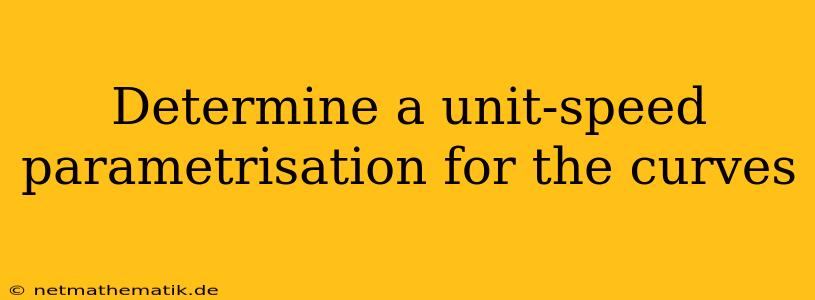Determining a unit-speed parameterization for a curve is a fundamental task in differential geometry. It allows us to analyze the curve's geometric properties, such as curvature and torsion, in a more natural and intuitive way. This process involves reparameterizing the curve so that the speed of a point moving along the curve is always one. In this article, we will explore the methods and applications of finding a unit-speed parameterization for various types of curves.
Understanding Unit-Speed Parameterization
A unit-speed parameterization of a curve $\alpha(t)$ is a reparametrization $\beta(s)$ such that the speed of the curve is always 1. In other words, the magnitude of the tangent vector, $|\beta'(s)|$, is equal to 1 for all values of $s$.
Why is this important?
- Geometric Simplicity: A unit-speed parameterization simplifies the analysis of a curve's geometric properties. For example, the curvature of a curve is defined as the magnitude of the derivative of the unit tangent vector with respect to arc length. This formula becomes much simpler when the curve is parameterized by arc length.
- Invariant Properties: Properties like curvature and torsion are independent of the parameterization of the curve. However, these properties are often easier to calculate and interpret using a unit-speed parameterization.
- Natural Description: In many applications, a unit-speed parameterization provides a more natural way to describe the curve, especially when dealing with physical quantities like velocity and acceleration.
Steps to Find a Unit-Speed Parameterization
To find a unit-speed parameterization for a given curve $\alpha(t)$, we can follow these steps:
- Calculate the Arc Length:
- Find the arc length function $s(t)$ for the curve $\alpha(t)$: $s(t) = \int_{t_0}^t |\alpha'(u)| , du$
- Here, $t_0$ is a fixed starting point on the curve.
- Find the Inverse Function:
- Solve the arc length function for $t$ as a function of $s$: $t = s^{-1}(s)$
- This gives you the inverse function of the arc length function.
- Reparameterize the Curve:
- Substitute $t$ with $s^{-1}(s)$ in the original curve $\alpha(t)$: $\beta(s) = \alpha(s^{-1}(s))$
- This new parameterization $\beta(s)$ is a unit-speed parameterization of the original curve.
Examples of Unit-Speed Parameterizations
Let's illustrate this with a few examples:
Example 1: A Circle
Consider the circle parameterized by: $\alpha(t) = (r \cos(t), r \sin(t)), \quad 0 \le t \le 2\pi$
- Calculate the Arc Length: $|\alpha'(t)| = |(-r \sin(t), r \cos(t))| = r$ $s(t) = \int_0^t r , du = rt$
- Find the Inverse Function: $t = \frac{s}{r}$
- Reparameterize the Curve: $\beta(s) = \alpha(s/r) = (r \cos(s/r), r \sin(s/r)), \quad 0 \le s \le 2\pi r$
This is the unit-speed parameterization of the circle, where the parameter $s$ represents the arc length along the circle.
Example 2: A Helix
Consider the helix parameterized by: $\alpha(t) = (r \cos(t), r \sin(t), ht), \quad t \in \mathbb{R}$
- Calculate the Arc Length: $|\alpha'(t)| = |(-r \sin(t), r \cos(t), h)| = \sqrt{r^2 + h^2}$ $s(t) = \int_0^t \sqrt{r^2 + h^2} , du = t\sqrt{r^2 + h^2}$
- Find the Inverse Function: $t = \frac{s}{\sqrt{r^2 + h^2}}$
- Reparameterize the Curve: $\beta(s) = \alpha(s/\sqrt{r^2 + h^2}) = \left(r \cos\left(\frac{s}{\sqrt{r^2 + h^2}}\right), r \sin\left(\frac{s}{\sqrt{r^2 + h^2}}\right), \frac{hs}{\sqrt{r^2 + h^2}}\right), \quad s \in \mathbb{R}$
This is the unit-speed parameterization of the helix, where $s$ represents the arc length along the helix.
Applications of Unit-Speed Parameterizations
Unit-speed parameterizations have numerous applications in various fields, including:
- Differential Geometry: They are crucial for understanding the geometric properties of curves, such as curvature, torsion, and the Frenet frame.
- Computer Graphics: They play a key role in curve and surface modeling, allowing for the creation of smooth and realistic shapes.
- Robotics: They are used in path planning for robots and other automated systems, ensuring efficient and smooth motion.
- Physics: They are applied in the study of particle trajectories and the motion of objects under forces.
Conclusion
Determine a unit-speed parametrisation for a curve is a fundamental concept in differential geometry. By reparameterizing a curve using arc length, we can simplify calculations, gain insights into the curve's geometric properties, and obtain a more natural description of the curve's shape. This technique has wide applications in various fields where curves play a crucial role. Understanding and applying unit-speed parameterizations provides a powerful tool for analyzing and manipulating curves in a more insightful and elegant manner.
